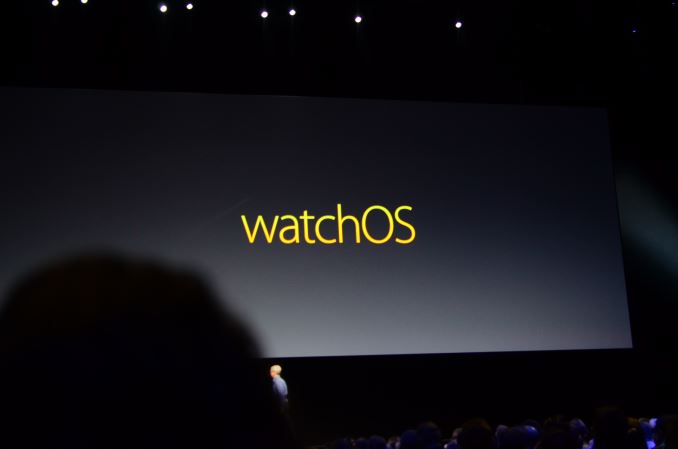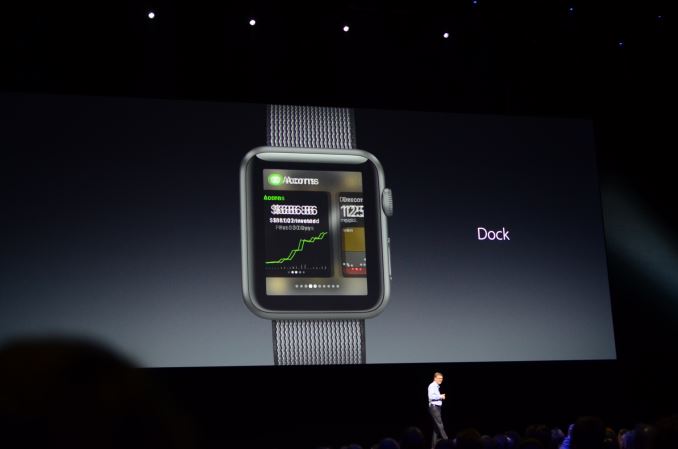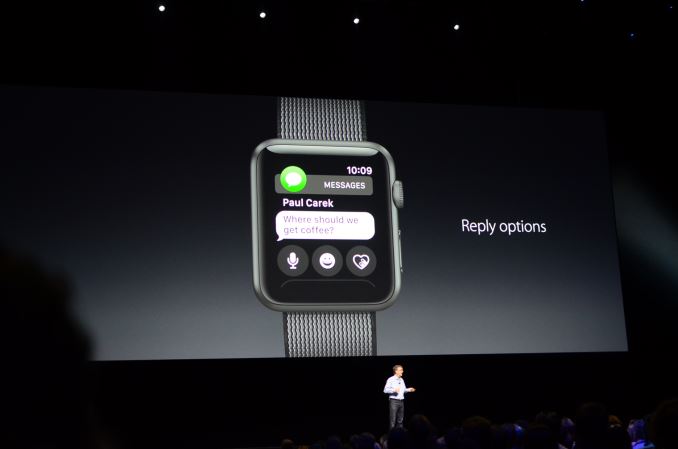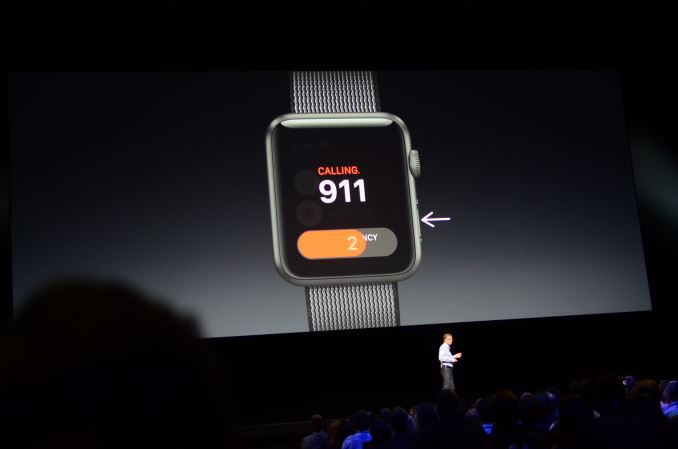Apple Announces WatchOS 3
by Joshua Ho on June 13, 2016 9:00 PM EST- Posted in
- Mobile
- Apple
- Apple Watch
- WatchOS
- Smartwatch
- watchOS 3

While Apple Watch and watchOS 1 was a solid first step towards seriously addressing the smartwatch market, it was obvious to me that it was still in need of development. Apple had come far, but still had far to go. With watchOS 3, we’re finally starting to see the refinements needed to make watchOS truly mass market, with focuses on responsiveness and adds a fair number of new features to help make the overall user experience more compelling.
At an OS level, the rather painful loading screens seen in previous iterations of watchOS are now dead, which is a fairly massive improvement. I’m not sure what architectural changes happened here yet, but it’s likely that offloading more compute onto the watch and periodic refresh of app data on the watch, along with more advanced multitasking is a fairly critical part of making all of this happen. It’s likely that this will have a power impact, but given the user experience improvements I think this is likely to be an acceptable trade-off.
Other than this architectural change, there have been a number of changes to the UI. Rather than overloading Glances with both a control center and various other glances, it looks like the two have been separated to better mesh with how iOS works. Rather than placing contacts on the side button, it looks like a Dock for apps launches instead. Other UI changes include a simple swipe to change the watchface on the fly and improved notification handling to make interactions like replying to a message from the watch faster than before.
On the feature side, apps like Activity now feature a multiplayer component by allowing you to share your activity data with friends and family. Activity also supports wheelchair mode to allow for more widespread usability, and has a whole host of new algorithms designed to properly track activity for those that are wheelchair-bound. There’s also a Breathe app, which is supposed to make it easier for people to do deep breathing/meditative breathing, along with Home for remote control of smart home devices. There’s also support for in-app Apple Pay, Mac unlock with Watch proximity, and SOS mode to automatically call emergency services with a long hold of the side button. There’s also improved workouts, with the ability to set no time limit for a workout and automatic workout pausing based upon motion detection.
Overall, watchOS 3 is starting to feel like it’s approaching what I really want from a smartwatch in terms of functionality and polish, and I think with Apple Watch 2 or 3 and maybe watchOS 4 or 5 we’ll finally see a smartwatch that I can whole-heartedly recommend for the first time, although it’s definitely possible that a company other than Apple may pull this off first. WatchOS 3 will be available in beta this summer, and will release to all Apple Watches this fall.














20 Comments
View All Comments
erikiksaz - Tuesday, June 14, 2016 - link
One thing I've noticed about apple watches in general, they're typically worn by people in their 50s. My sample is from about 2k+ clients a year, so take that for what it's worth. I just think it's funny because Apple's products are generally predicated on being the "cool" option, but this watch doesn't appeal to the same crowd of Starbucks-sipping, snapchat-surfing, macbook air-toting millennials.sc14s - Tuesday, June 14, 2016 - link
I will probably take this with a massive grain of salt as I literally see the opposite here in silicon valley. The majority of apple watch users that i've seen have been in the 20-30 age range. I have maybe seen 1-2 users 40+Samus - Tuesday, June 14, 2016 - link
34, Apple Watch, graduated from a Pebble. Kind of miss the durability, otherwise love the Apple Watch. Wife is 33, has a Watch too. Haven't seen a single person in their 50's with one. Most older people laugh at it, and wear nice looking traditional watches. I know some in their 40's but nobody in their 50's.damianrobertjones - Tuesday, June 14, 2016 - link
I only know 1 person, where I work, with the Apple watch... The MD who's over 50. :)BrokenCrayons - Tuesday, June 14, 2016 - link
I've seen a few younger people with fitbits, but those are kind of vanishing as the faddishness of fitness bands has started to wear thin already and they end up laying on dressers all day instead. However, more full-featured smart watch platforms do appear to be the domain of older people from my limited personal experience. Yes, many older people wear conventional, nice looking watches (men in particular as its a status symbol and one of only a few pieces of socially accepted jewelry that fit into male fashion). I think there's a divergent pair of watch wearing groups among the elderly. Those that are more bling-seeking sorts who tend to be a bit on the gaudy side of fashion are the ones that also seem willing to purchase a smart watch. The more conservative dressing sorts that slip into the classic nicely dressed attire commonly seen among the wealthy of 30 years ago lean away from device-based watches and opt for subdued jewelry-like conventional watches. Because of that, I think it's hard to just look at the elderly in general and say they as a group are the target audience for Apple's Watch. You also can't discount the outliers who are in their early 30s that are dealing with children and family life that's bringing up subconscious fears of being tech-stagnant like their parents. Those sorts will most certainly be fewer in numbers, but the ones that do exist will be voracious in seeking out ways to feel as if they're keeping up with technology and societal changes. The cost of a smart watch is a pretty small price to pay in order to get some temporary relief and to have a conversation piece that can start chatter in their workplaces.Osamede - Wednesday, June 15, 2016 - link
Actually its more about price point and functionality.The most of the people I see with Apple watch are 40+, comfortable with tech but not cutting edge - and have a lot of money. They can afford an extra device that is more about personal style than necessity.
ON the other hand, almost everyone I have seen with Samsing Gear S and similar "proper phonewatch" are in their 20s or early 30s and are much more the tech early adopted type.
Azryder - Tuesday, June 14, 2016 - link
There are "elderly" folks out there that embrace technology. This 67 year old "granny" who is also a fitness instructor, personal trainer and cyclist who rides about 150 miles a week is in love with her new Apple Watch. Heading to the Canadian Rockies, Switzerland and New Zealand in the next eight months on cycle tours. Give me my Garmin 810, iPad Mini, iPhone 6s and I am off and running. Don't count us "old" folks out, we aren't sitting on the couch knitting. We LOVE the convenience of the new technology!BrokenCrayons - Tuesday, June 14, 2016 - link
I don't think anyone's mentioned physical activities beyond my brief comment about fitness monitors and their waning popularity and that comment didn't imply even the disinterested owners of the aforementioned were somehow turning into couch potatoes as a consequence of not finding any use in having purchased something like a fitbit. Furthermore, no one is discounting older consumers. We have disposable income, have long since emptied our nests, and are busy seeking out ways to keep ourselves active, distracted, and entertained (well some of us anyway). I think the discussion points above are meant to make observations about the market segments to which smart watches appeal and why rather than delve into the lifestyles of each individual consumer.FunBunny2 - Tuesday, June 14, 2016 - link
-- Furthermore, no one is discounting older consumers. We have disposable income, have long since emptied our nests, and are busy seeking out ways to keep ourselves active, distracted, and entertained (well some of us anyway).you've expressed the observation of the general trend on income concentration. it used to be that kids spent their money on toys because they could. these days most excess/disposable income rests with the 1%, who are, despite what some press organs spew, mostly angry old white men; aka Trumpers. in order to separate them from their moolah, ever more clever gadgets will be put on offer. mass consumption no longer drives the economy, but rather varigated consumption of the elite. get used to it.
vortmax2 - Wednesday, June 15, 2016 - link
"We have disposable income" - who needs disposable income when you're young? lol...